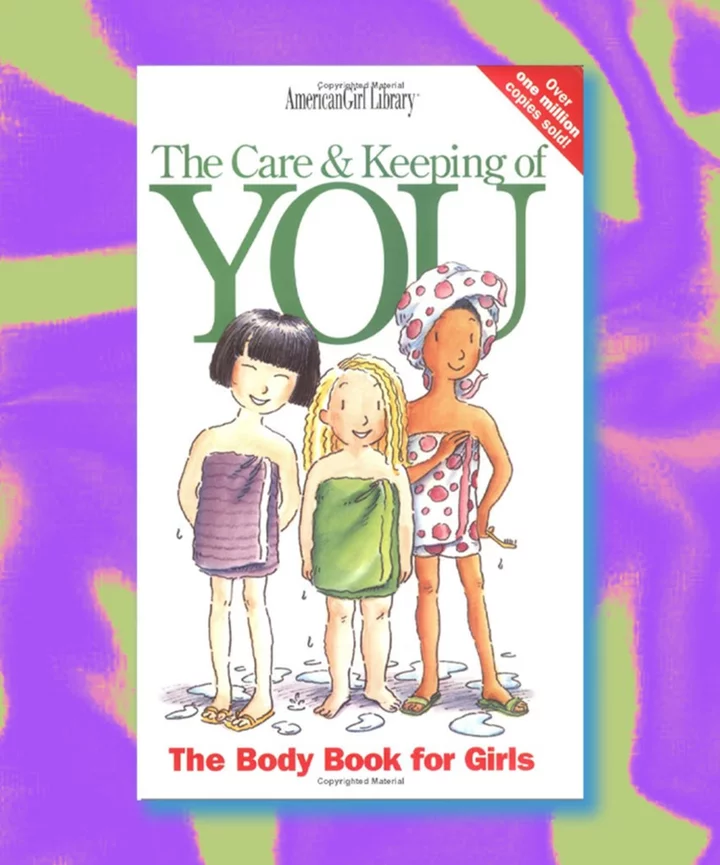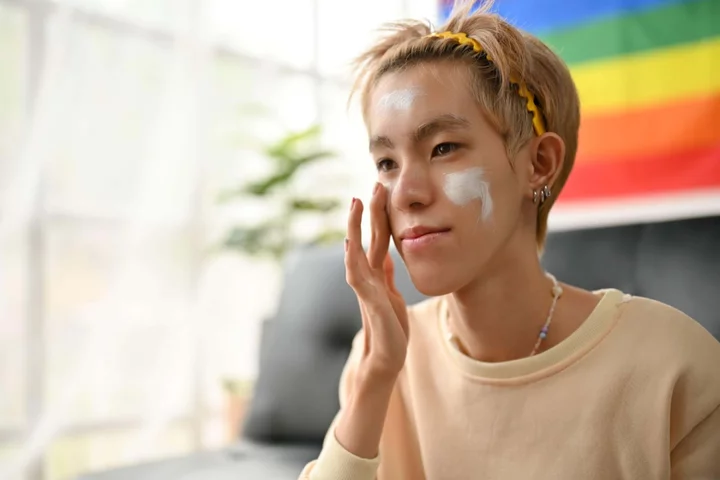Education is often called the Great Equalizer but in my mind, what truly makes us equal is the most embarrassing, weird, confusing chapter we’re all fated to go through in life: puberty. And we get to experience this magical yet scary time in our own humbling, humanizing way during our most formative years — but we don’t get through it without help along the way.
On September 1, The Care and Keeping of You: The Body Book for Girls, turned 25. The American Girl book has sold over six million copies since it first published in 1998, and its relevance has stayed well within the cultural zeitgeist and only grown over the years, influencing people to make TikToks with comments calling the book “the sacred texts,” inspiring Halloween costumes, bringing people together who were slightly traumatized by that page (and there are many), and reminding us that judgment-free sex education does exist out there. Its contents span periods, breast development, emotions, hair and skin care, sleep hygiene, and more. It’s a guide to not only knowing your body, but learning how to take care of it, too. And for the past quarter of a century, it has often taken the place of (or at least heavily supplemented) young people’s — particularly people with vulvas — early sex education in the U.S., which is often rudimentary at best.
While 39 states and Washington, D.C. mandate some kind of sex education, only 17 of those are required by law to be medically accurate, which is left up to the states to define. Last year, the Guttmacher Institute came out with a study that found young people were less likely to say they received sex education on key topics in the years 2015 to 2019 than they were in 1995. In 2021, Refinery29 conducted a survey of 1,425 people across the U.S., U.K., and Canada, and found that while 80% of the respondents said they received formal sex education in school, only 5% of them believed it fully prepared them for the real world.
The stats on the failures of U.S. sex ed are alarming, and should incite urgency in our government to prioritize sufficient education for young people. But instead, they’re doing the opposite. The overturning of Roe v. Wade was a major setback for reproductive health and created an even more urgent need for proper sex ed in schools, and since then even more backwards legislation has been introduced. Two notably harmful bills out of Florida are H.B. 1557, also known as the “Don’t Say Gay” bill, which bans schools from “encouraging classroom instruction about sexual orientation or gender identity in primary grade levels” and H.B. 1069, also known as the “Don’t Say Period” bill, which bans schools from teaching about subjects such as menstruation and sexuality before the sixth grade (meaning that The Care and Keeping of You would, effectively, be a banned book.) The Texas GOP’s 2022 platform also stated that they would ban “teaching of sex education, sexual health, or sexual choice or identity in any public school.”
While these bills are on the newer side, the state of sex ed in the U.S. has long been abysmal. And since we can’t rely on our government to provide us with comprehensive education about our bodies, outside sources and books like The Care and Keeping of You are more important for young people to have access to now than ever, even 25 years later.
While a book for pubescent tweens and teens can’t possibly cover every topic about growing up in today’s world, Justine Ang Fonte, M.Ed, MPH, a sexuality educator and professor, says it’s done a good job — by 1998 standards and today’s. “It talks a lot about the body changing through a celebratory tone, which is very uncommon in general sex ed and puberty education,” she says. Fonte notes that the 1998 version of the book didn’t shy away from showing what’s happening to people’s bodies in a realistic way, from changing breast shapes to pubic hair to medically accurate vulvas, and it even had practical advice and scripts for how to communicate your feelings productively. It was written through the lens of, “listen to your body and tune in to what your body is telling you,” Fonte notes. “I think that’s a really progressive approach, even still in 2023, and not the tone that most puberty and sex education takes.”
“I remember my friend and I in the fourth grade would always pull out the book and then try to determine where we were in the breast development stages, and we always thought we were way further along in development than we probably were.”
Nadya OkamotoThere are very specific parts of the book that have stood out to us as kids and have stuck with us into adulthood. For me, it was the “how to put in a tampon” section, mainly because I never learned the steps in school — in fact, the day we learned about periods we all received a single pad to take back home to practice with (or to have in case of an emergency? I’m still unsure) without any mention of what a tampon was or how to use it. The specific, slightly traumatizing diagram in the book still pops into my mind every time I have my period, because it was something I had to use and rely on.
Not only did this book teach us, but it gave groups of pubescent tweens a sense of togetherness and understanding (and also language for how to talk about the confusing things happening to our bodies). For Nadya Okamoto, author of Period Power: A Manifesto for the Menstrual Movement and founder of August, an inclusive period care brand, it was the diagram of breast shapes and stages. “I remember my friend and I in the fourth grade would always pull out the book and then try to determine where we were in the breast development stages, and we always thought we were way further along in development than we probably were,” she says.
Emily S. tells Refinery29 that books like The Care and Keeping of You were essential to her growing up. “Any time I wanted to ask my mom something about puberty, I remember standing outside her bedroom door and kind of hyping myself up,” she tells Refinery29. “It’s not like we had a weird relationship or anything, I was just really shy.” Like Okamoto, Emily remembers the breast stage section as necessary sleepover conversation. Now, she makes content on TikTok centered around periods, puberty, bodies, and disabilities, and the book has made many appearances — and started many conversations — on her page.
The Care and Keeping of You is a piece of puberty history, and many people across the U.S. have their own mortifying, yet comfortingly similar experiences with it. And while this book is widely loved and celebrated and helmed as a progressive piece of education, its first crop of consumers are grown up now — and they have thoughts. As with anything that comes from decades past, there are some things that should be left behind. Or, at least, updated.
Even if our sex ed doesn’t reflect it, we as a collective have evolved a significant amount when it comes to how we think and talk about gender roles, identity, queerness, and sexuality in the past 25 years. In the older and newer version of the book, a line is included that alludes to the reader noticing “boys in a different way” as they get older, which is something that can and should be changed to be more inclusive of all genders and orientations. If The Care and Keeping of You can acknowledge sexual attraction, then they can acknowledge queerness, too.
Looking back, Okamoto says the heteronormativity in the book jumps out at her. “I’m very passionate about gender-inclusive language around periods. When we talk about people who have periods, we don’t always say women, we say menstruators or people with periods,” says Okamoto.
@pairofhodos fake body of course! but seriously… why the step backwards? #thecareandkeepingofyou #thebodybookforgirls #censorship #americangirl #padsandtampons #healtheducation ♬ original sound – HodosEmily thinks that the book should acknowledge intersex people, have deeper conversations around emotional and physical boundaries and consent, and label the clitoris on the diagram of a vulva, among other things. Fonte has a list of suggestions for changing up the language and certain content of the book, and one of her concerns was the section that touched on our relationships with food and disordered eating, and named specific kinds of eating disorders (which, to note, was taken out of the revamped version in 2013). “It’s destructive to even be mentioning eating disorders because it introduces it to [the reader],” she says. “And in the way that the book did it, it was instructive. So, if I had never heard of the word anorexia before, I’m now reading about it and it’s telling me some girls might experience anorexia and they might do this to lose weight. If I’m a girl who’s nine years old and I’ve been told I’m fat and that’s bad and that’s negative, that I need to become thin, now I’m reading this section and I’m not seeing the word disorder… I’m seeing this as an instruction plan for me about how I can no longer be fat.”
Among topics that should be added, Fonte brings up endometriosis, a condition that roughly 10% of reproductive-aged people experience. “We have so many menstruators that are out there with endometriosis and are being blamed or attacked for being wimps, and because people don’t know about it much, they don’t believe them,” she says. Fonte also adds that going into gender identity would be a good addition as some kids grow up not feeling like they were born into the right bodies, and in return the book would be able to be more inclusive towards trans, nonbinary, and gender-nonconforming folks.
“The book is for cis, straight girls,” Okamoto says. “There is quite a bit that I would change.” And, actually, so would the authors.
Valorie Lee Schaefer, author of the first version of The Care and Keeping of You, agrees that some aspects of it seem a bit dated when looking back today. “The book is being updated periodically to include new research and available products, and to reflect new thinking about health, nutrition, and overall wellness,” she tells Refinery29. “I hope we’ll continue to keep pace with changing views on puberty, and to celebrate even more body shapes, ethnicities, and abilities in future editions!”
Cara Natterson, MD, pediatrician and author, who revised and expanded on the original content of The Care and Keeping of You in 2013 and also wrote the companion book, The Care and Keeping of You 2: The Body Book for Older Girls, would like to use more inclusive illustrations. “Looking back, I wish the book had more diverse visual representations of kids, from body shapes and sizes and skin tones to hair and clothing styles, too,” Dr. Natterson says.
Fonte agrees. “The young people in my life do not look like that book,” she says. “I didn’t see anyone in a hijab. I didn’t see anyone in a wheelchair, in crutches. I didn’t see different types of bodies. [The book] was really missing out on other intersectional aspects of what bodies and identities can look like.” And remember, two things can be true at once: The book has, undoubtedly, helped scores of young people be informed about their changing bodies. The book, also, has some work to do.
And Mattel is listening. In an email to Refinery29, they revealed that The Care and Keeping of You 1 and 2 are both getting updated and revamped with an aimed release of January 2024. While they can’t explicitly say what they’re changing, Dr. Natterson says that all of her concerns above have been “thoughtfully addressed.”
Dr. Natterson’s work in this space isn’t over yet, and she has another puberty-related book being published with her company, Order of Magnitude. “We have a book coming out called This Is So Awkward: Modern Puberty Explained that describes the journey starting at the beginning — for today’s girls it starts between 8-9 and for boys between 9-10 — and includes several chapters about sex, sexuality, STIs, and contraception,” she says. “We’re also working on revamping school-based curriculum and communicating with adults to answer their questions because growing up looks very different than it used to.”
Looking back, Schaefer is proud of what the books have been able to accomplish in the past 25 years. “What’s been really sweet to see is the way the book seems to occupy this place of misty nostalgia for women who are now in their 20’s and 30’s,” she says. “I imagine them rifling through boxes of childhood mementos and stumbling upon their dog-eared copy of the book, packed beneath their well-loved stuffed animals and photos from slumber parties. Many women seem to regard the book — and their girlhood selves — with so much tenderness and affection all these years later.”
Much like our bodies, the world is constantly changing. We owe it to future generations to continue to evolve and grow just as The Care and Keeping of You allowed us to, all those years ago.









